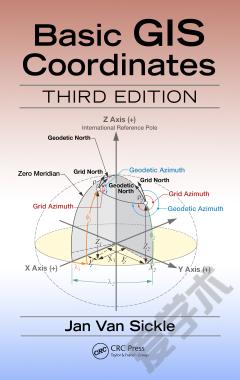Basic GIS Coordinates
Coordinates are the foundation of GIS, cartography, and surveying, to name just a few fields. Computers have an astounding capacity for repetition and they possess a superior ability to handle the mathematics behind coordinate manipulationbut they are very bad at interpreting coordinates and coordinate systems. Basic GIS Coordinates, Second Edition clearly illustrates the basic principles of coordinate systems, covering ellipsoids, datums, and plane coordinates as they are used in GIS and GPS. Keeping in mind that it is ultimately incumbent on humans to ensure the correct use of coordinate systems, this book explains complex topics in a logical progression, presenting them in a way that is neither too complicated nor oversimplified. This new edition of a bestseller expands the material with updates on what has occurred in the field during the past five years, especially in the World Geodetic System and International Terrestrial Reference Frame. It also addresses the upcoming GNSS constellations and coordinate implications. Details how to build a coordinate system Addresses different methods of leveling, as well as measuring and modeling of height and gravity Explores two-coordinate (state-plane, UTM) systems Discusses initial points and other aspects of the rectangular system Covers the geoid and the concepts of elevation There are thousands of horizontal geodetic datums and Cartesian coordinate systems currently sanctioned by governments around the world to describe our planet electronically and on paper. Even if a computer has done nothing wrong, coordinate errors can often occur and lead to potentially disastrous miscalculations. This book is a valuable tool to help readers develop an understanding of how coordinate systems workand how they sometimes dont.
{{comment.content}}








 京公网安备 11010802027623号
京公网安备 11010802027623号